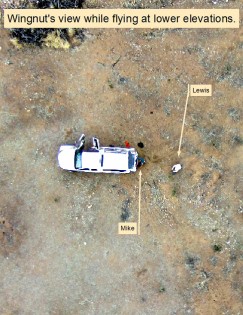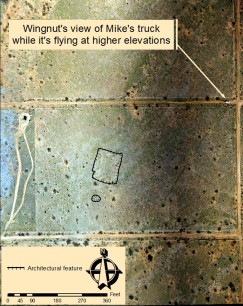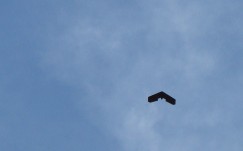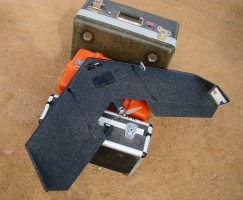- Home
- >
- Preservation Archaeology Blog
- >
- Of Drones and Men

August 20, 2013
Earlier this spring, I had the pleasure of getting out into Sulphur Spring Valley’s sere landscape with Michael Brack, a cartographer from Desert Archaeology, Inc. We were there to map a number of Classic period archaeological sites that will be important for my dissertation and for Archaeology Southwest’s new research initiative, the Edge of Salado.
Mike and I had never met before, so, as I packed, I felt the normal, subtle anxiety that precedes these types of long-term trips with strangers. I shouldn’t have worried, though, because Mike and I got along quite well. I consider myself lucky to have made a new friend on that trip—well, two friends, actually, but I’ll get to that.

The main purpose of this trip was to map a number of sites using photographs captured by a remote aerial vehicle, which most of us have become quite familiar with, thanks to recent government bombings. (Mike’s drone really only puts us at risk of getting photobombed, though.) The end result of this mapping process—which takes the photographs, finds common points between multiple images and then creates a cloud of points much like with LIDAR technology—is a high-resolution (1.5 cm), 3-D image of the topography and architectural features of an area. And this is why I say that I made two friends: Mike is a wonderful cartographer, excellent field archaeologist, great drone operator, and all-around great guy, but in the end, it’s the drone that will enable fast, high-resolution, 3-D imaging of these sites.
At some point in the field, while I was looking up and tracking the drone against the cobalt backdrop to make sure that the curious raptors were not getting too close or too aggressive, I realized that it looked exactly like a flying wingnut. I mentioned this to Mike, and he said that he’d been looking for a name for the drone for a while, and that Wingnut was a great fit.
Now, this really is important, because we often need to humanize machinery. We certainly do it with our cars, and those of us who are a bit nerdier do it with our computers and our phones (and now, it would seem, drones). Of course, this follows a long line of humanizing computers and machines in film and books. Although our interaction with these humanized creations doesn’t always end well (2001’s HAL 9000, War Games, Christine), it frequently does (C3PO and R2D2 from Star Wars, Johnny 5 from Short Circuit, all of the Autobots from Transformers, most of the robots from Isaac Asimov’s sci-fi universe, and KITT from Knight Rider).
Thus, with those happier instances in mind, I’m happy to say that I have a new friend, a friend who is pretty good at surfing the desert skies and obtaining amazing information to help archaeologists understand just what exactly was going on 600–700 years ago. So, thanks, Wingnut, for putting up with a lot of crazy wind, some irritated raptors, and two dusty archaeologists.
http://www.youtube.com/watch?v=dt_mF6l8Who&feature=youtu.be
4 thoughts on “Of Drones and Men”
Comments are closed.
Explore the News
-
Join Today
Keep up with the latest discoveries in southwestern archaeology. Join today, and receive Archaeology Southwest Magazine, among other member benefits.



Cheers, Lewis. Gracias. I’m looking forward to our next desperado mission.
And many thanks to a single Swiss engineer that believed he could do it and did.
See http://www.rupestrian.com/panoramas.html
and
http://www.rupestrian.com/stitching-air-photos.html